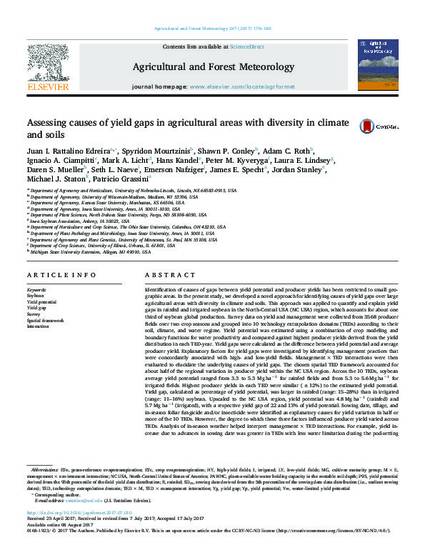
Identification of causes of gaps between yield potential and producer yields has been restricted to small geographic areas. In the present study, we developed a novel approach for identifying causes of yield gaps over large agricultural areas with diversity in climate and soils. This approach was applied to quantify and explain yield gaps in rainfed and irrigated soybean in the North-Central USA (NC USA) region, which accounts for about one third of soybean global production. Survey data on yield and management were collected from 3568 producer fields over two crop seasons and grouped into 10 technology extrapolation domains (TEDs) according to their soil, climate, and water regime. Yield potential was estimated using a combination of crop modeling and boundary functions for water productivity and compared against highest producer yields derived from the yield distribution in each TED-year. Yield gaps were calculated as the difference between yield potential and average producer yield. Explanatory factors for yield gaps were investigated by identifying management practices that were concordantly associated with high- and low-yield fields. Management × TED interactions were then evaluated to elucidate the underlying causes of yield gaps. The chosen spatial TED framework accounted for about half of the regional variation in producer yield within the NC USA region. Across the 10 TEDs, soybean average yield potential ranged from 3.3 to 5.3 Mg ha−1 for rainfed fields and from 5.3 to 5.6 Mg ha−1for irrigated fields. Highest producer yields in each TED were similar (±12%) to the estimated yield potential. Yield gap, calculated as percentage of yield potential, was larger in rainfed (range: 15–28%) than in irrigated (range: 11–16%) soybean. Upscaled to the NC USA region, yield potential was 4.8 Mg ha−1 (rainfed) and 5.7 Mg ha−1 (irrigated), with a respective yield gap of 22 and 13% of yield potential. Sowing date, tillage, and in-season foliar fungicide and/or insecticide were identified as explanatory causes for yield variation in half or more of the 10 TEDs. However, the degree to which these three factors influenced producer yield varied across TEDs. Analysis of in-season weather helped interpret management × TED interactions. For example, yield increase due to advances in sowing date was greater in TEDs with less water limitation during the pod-setting phase. The present study highlights the strength of combining producer survey data with a spatial framework to measure yield gaps, identify management factors explaining these gaps, and understand the biophysical drivers influencing yield responses to crop management.
Available at: http://works.bepress.com/mark-licht/15/

This article is published as Edreira, Juan I. Rattalino, Spyridon Mourtzinis, Shawn P. Conley, Adam C. Roth, Ignacio A. Ciampitti, Mark A. Licht, Hans Kandel et al. "Assessing causes of yield gaps in agricultural areas with diversity in climate and soils." Agricultural and Forest Meteorology 247 (2017): 170-180. doi: 10.1016/j.agrformet.2017.07.010.